Competitive Strategy Analysis Report: Woolworths vs. Ford Motor
VerifiedAdded on 2020/02/24
|8
|1393
|79
Report
AI Summary
This report provides a competitive analysis of two major companies: Woolworths Limited, an Australian supermarket retail chain, and Ford Motor Company, a global automotive manufacturer. The analysis of Woolworths highlights its market capitalization in Australia, its strategic cooperation with Coles, and its focus on understanding market conditions and customer needs. The report explores Woolworths' strategies, including market evaluation, unique product propositions, resource management, and customer-centric approaches. The analysis of Ford focuses on its strategic internal management processes, including centralized leadership and decentralized policy implementation, product differentiation, and cost leadership. The report also examines Ford's product differentiation strategies, partnerships, and cost-effective production models. Both analyses emphasize the importance of adapting to market changes, understanding customer needs, and leveraging resources to gain a competitive edge in their respective industries, providing insights into their strategies for maintaining and expanding market share.
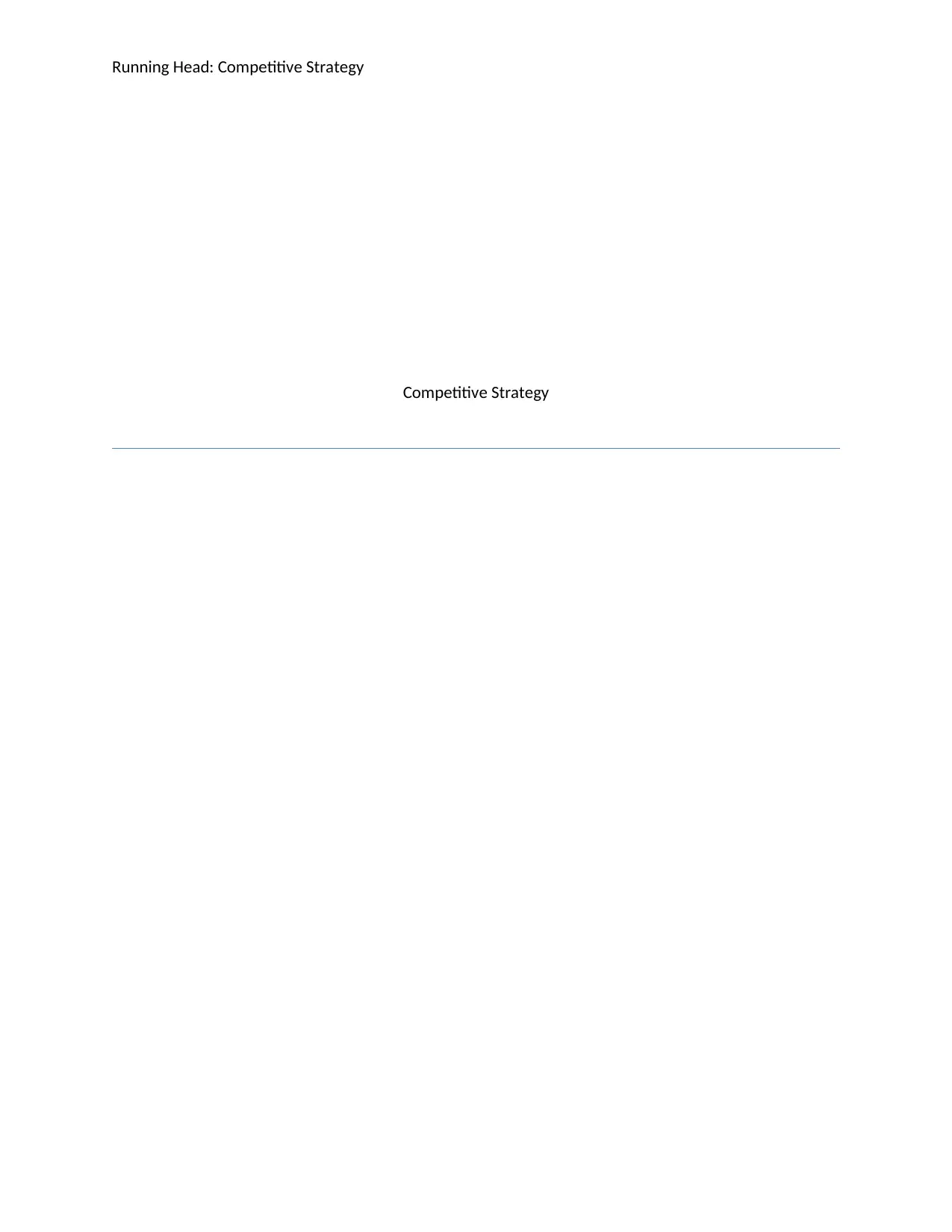
Running Head: Competitive Strategy
Competitive Strategy
Competitive Strategy
Paraphrase This Document
Need a fresh take? Get an instant paraphrase of this document with our AI Paraphraser
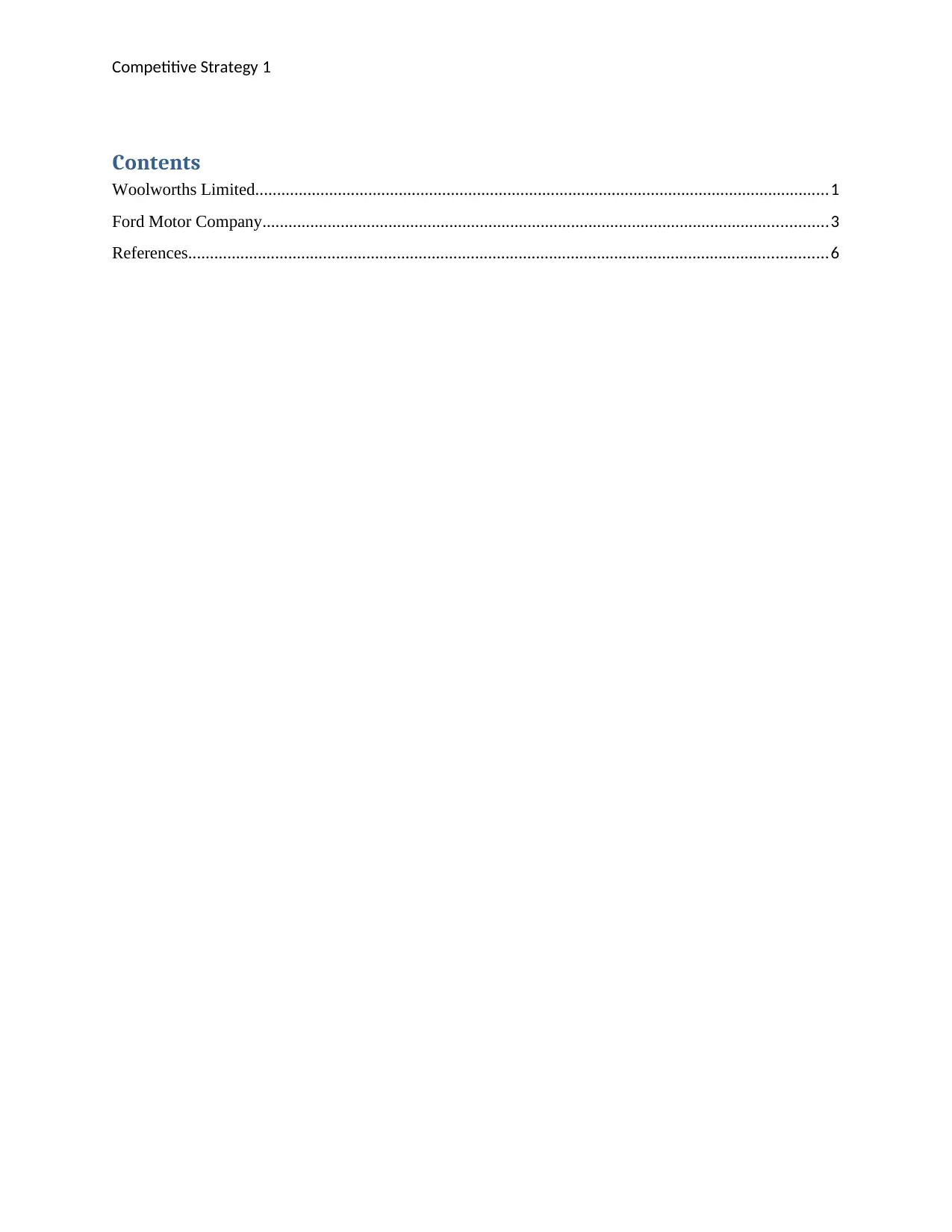
Competitive Strategy 1
Contents
Woolworths Limited....................................................................................................................................1
Ford Motor Company..................................................................................................................................3
References...................................................................................................................................................6
Contents
Woolworths Limited....................................................................................................................................1
Ford Motor Company..................................................................................................................................3
References...................................................................................................................................................6
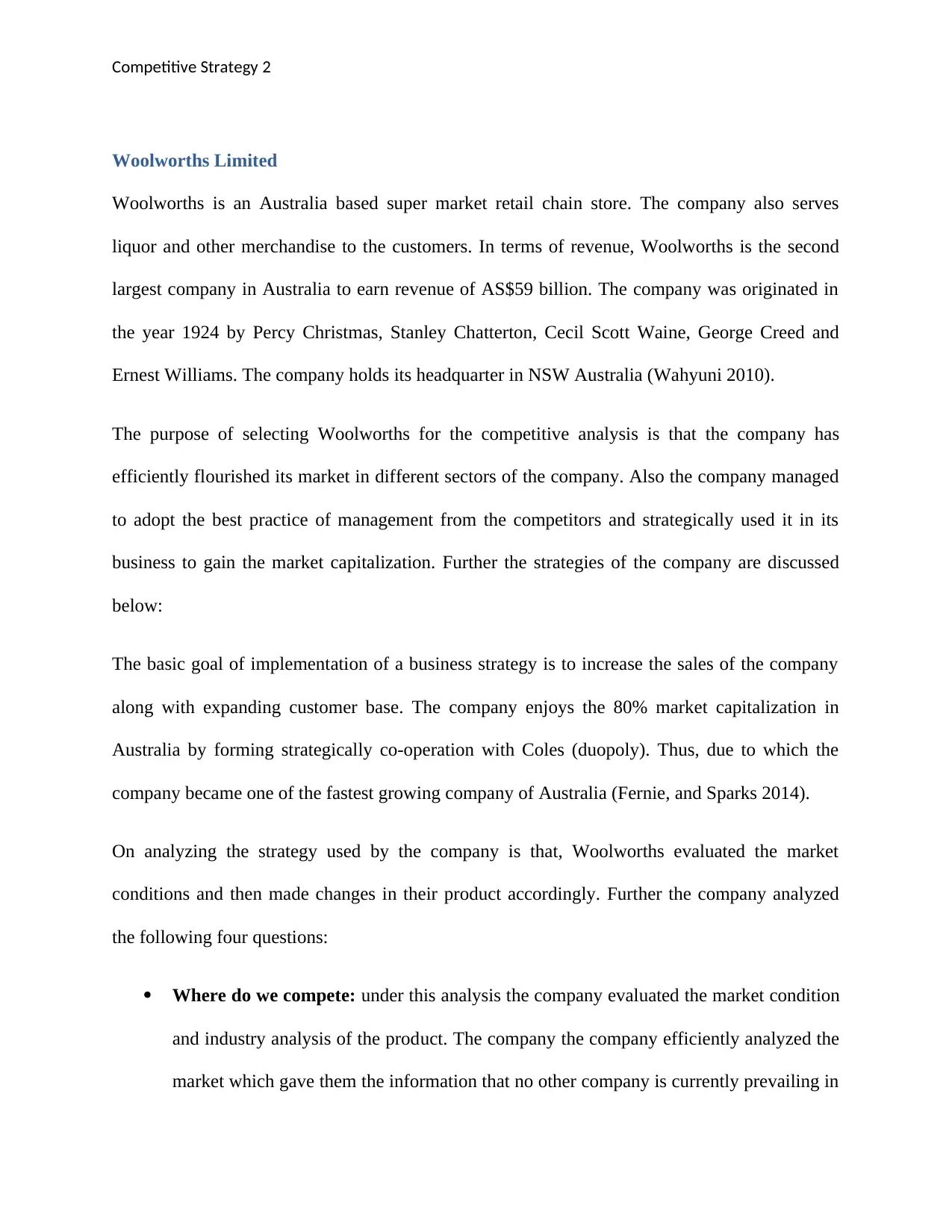
Competitive Strategy 2
Woolworths Limited
Woolworths is an Australia based super market retail chain store. The company also serves
liquor and other merchandise to the customers. In terms of revenue, Woolworths is the second
largest company in Australia to earn revenue of AS$59 billion. The company was originated in
the year 1924 by Percy Christmas, Stanley Chatterton, Cecil Scott Waine, George Creed and
Ernest Williams. The company holds its headquarter in NSW Australia (Wahyuni 2010).
The purpose of selecting Woolworths for the competitive analysis is that the company has
efficiently flourished its market in different sectors of the company. Also the company managed
to adopt the best practice of management from the competitors and strategically used it in its
business to gain the market capitalization. Further the strategies of the company are discussed
below:
The basic goal of implementation of a business strategy is to increase the sales of the company
along with expanding customer base. The company enjoys the 80% market capitalization in
Australia by forming strategically co-operation with Coles (duopoly). Thus, due to which the
company became one of the fastest growing company of Australia (Fernie, and Sparks 2014).
On analyzing the strategy used by the company is that, Woolworths evaluated the market
conditions and then made changes in their product accordingly. Further the company analyzed
the following four questions:
Where do we compete: under this analysis the company evaluated the market condition
and industry analysis of the product. The company the company efficiently analyzed the
market which gave them the information that no other company is currently prevailing in
Woolworths Limited
Woolworths is an Australia based super market retail chain store. The company also serves
liquor and other merchandise to the customers. In terms of revenue, Woolworths is the second
largest company in Australia to earn revenue of AS$59 billion. The company was originated in
the year 1924 by Percy Christmas, Stanley Chatterton, Cecil Scott Waine, George Creed and
Ernest Williams. The company holds its headquarter in NSW Australia (Wahyuni 2010).
The purpose of selecting Woolworths for the competitive analysis is that the company has
efficiently flourished its market in different sectors of the company. Also the company managed
to adopt the best practice of management from the competitors and strategically used it in its
business to gain the market capitalization. Further the strategies of the company are discussed
below:
The basic goal of implementation of a business strategy is to increase the sales of the company
along with expanding customer base. The company enjoys the 80% market capitalization in
Australia by forming strategically co-operation with Coles (duopoly). Thus, due to which the
company became one of the fastest growing company of Australia (Fernie, and Sparks 2014).
On analyzing the strategy used by the company is that, Woolworths evaluated the market
conditions and then made changes in their product accordingly. Further the company analyzed
the following four questions:
Where do we compete: under this analysis the company evaluated the market condition
and industry analysis of the product. The company the company efficiently analyzed the
market which gave them the information that no other company is currently prevailing in
⊘ This is a preview!⊘
Do you want full access?
Subscribe today to unlock all pages.

Trusted by 1+ million students worldwide
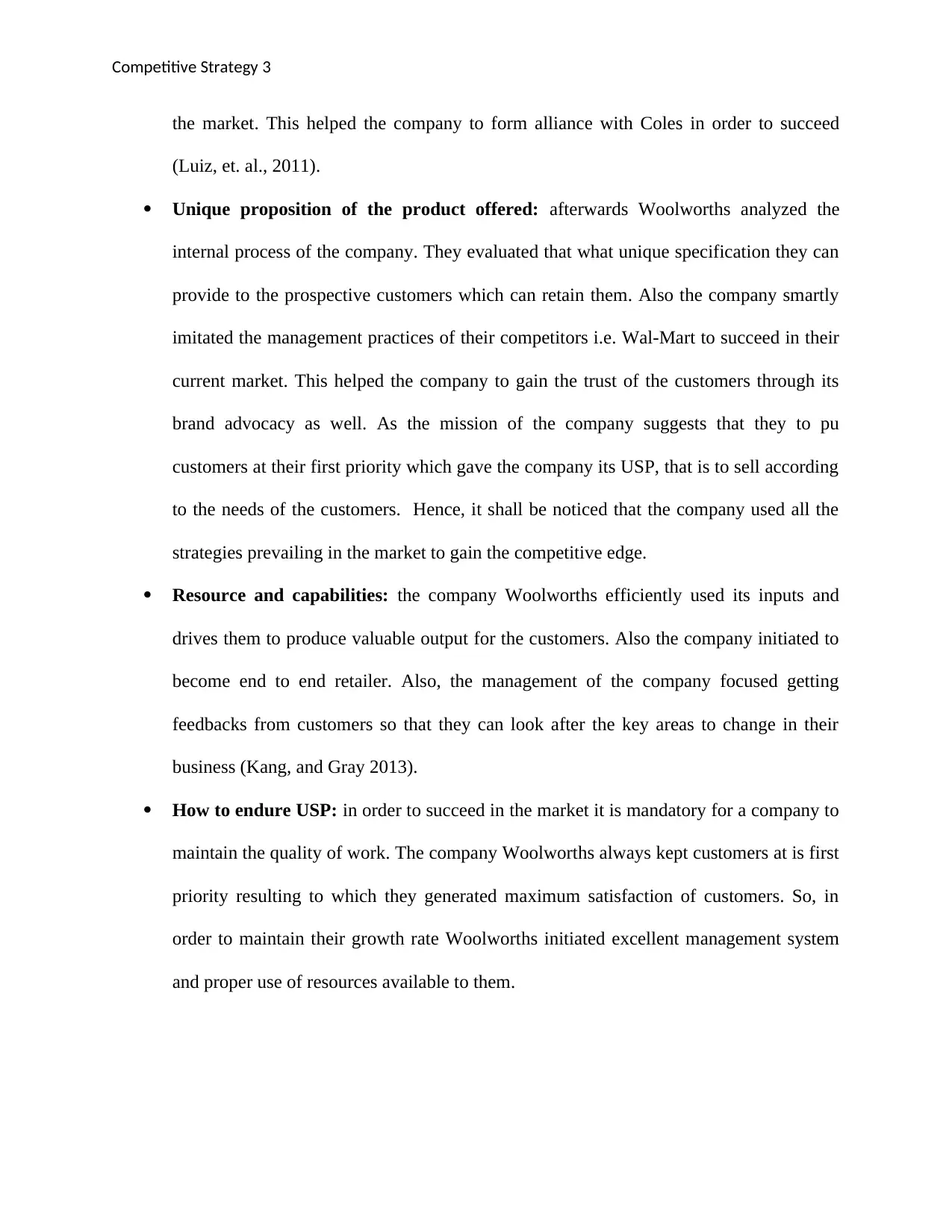
Competitive Strategy 3
the market. This helped the company to form alliance with Coles in order to succeed
(Luiz, et. al., 2011).
Unique proposition of the product offered: afterwards Woolworths analyzed the
internal process of the company. They evaluated that what unique specification they can
provide to the prospective customers which can retain them. Also the company smartly
imitated the management practices of their competitors i.e. Wal-Mart to succeed in their
current market. This helped the company to gain the trust of the customers through its
brand advocacy as well. As the mission of the company suggests that they to pu
customers at their first priority which gave the company its USP, that is to sell according
to the needs of the customers. Hence, it shall be noticed that the company used all the
strategies prevailing in the market to gain the competitive edge.
Resource and capabilities: the company Woolworths efficiently used its inputs and
drives them to produce valuable output for the customers. Also the company initiated to
become end to end retailer. Also, the management of the company focused getting
feedbacks from customers so that they can look after the key areas to change in their
business (Kang, and Gray 2013).
How to endure USP: in order to succeed in the market it is mandatory for a company to
maintain the quality of work. The company Woolworths always kept customers at is first
priority resulting to which they generated maximum satisfaction of customers. So, in
order to maintain their growth rate Woolworths initiated excellent management system
and proper use of resources available to them.
the market. This helped the company to form alliance with Coles in order to succeed
(Luiz, et. al., 2011).
Unique proposition of the product offered: afterwards Woolworths analyzed the
internal process of the company. They evaluated that what unique specification they can
provide to the prospective customers which can retain them. Also the company smartly
imitated the management practices of their competitors i.e. Wal-Mart to succeed in their
current market. This helped the company to gain the trust of the customers through its
brand advocacy as well. As the mission of the company suggests that they to pu
customers at their first priority which gave the company its USP, that is to sell according
to the needs of the customers. Hence, it shall be noticed that the company used all the
strategies prevailing in the market to gain the competitive edge.
Resource and capabilities: the company Woolworths efficiently used its inputs and
drives them to produce valuable output for the customers. Also the company initiated to
become end to end retailer. Also, the management of the company focused getting
feedbacks from customers so that they can look after the key areas to change in their
business (Kang, and Gray 2013).
How to endure USP: in order to succeed in the market it is mandatory for a company to
maintain the quality of work. The company Woolworths always kept customers at is first
priority resulting to which they generated maximum satisfaction of customers. So, in
order to maintain their growth rate Woolworths initiated excellent management system
and proper use of resources available to them.
Paraphrase This Document
Need a fresh take? Get an instant paraphrase of this document with our AI Paraphraser
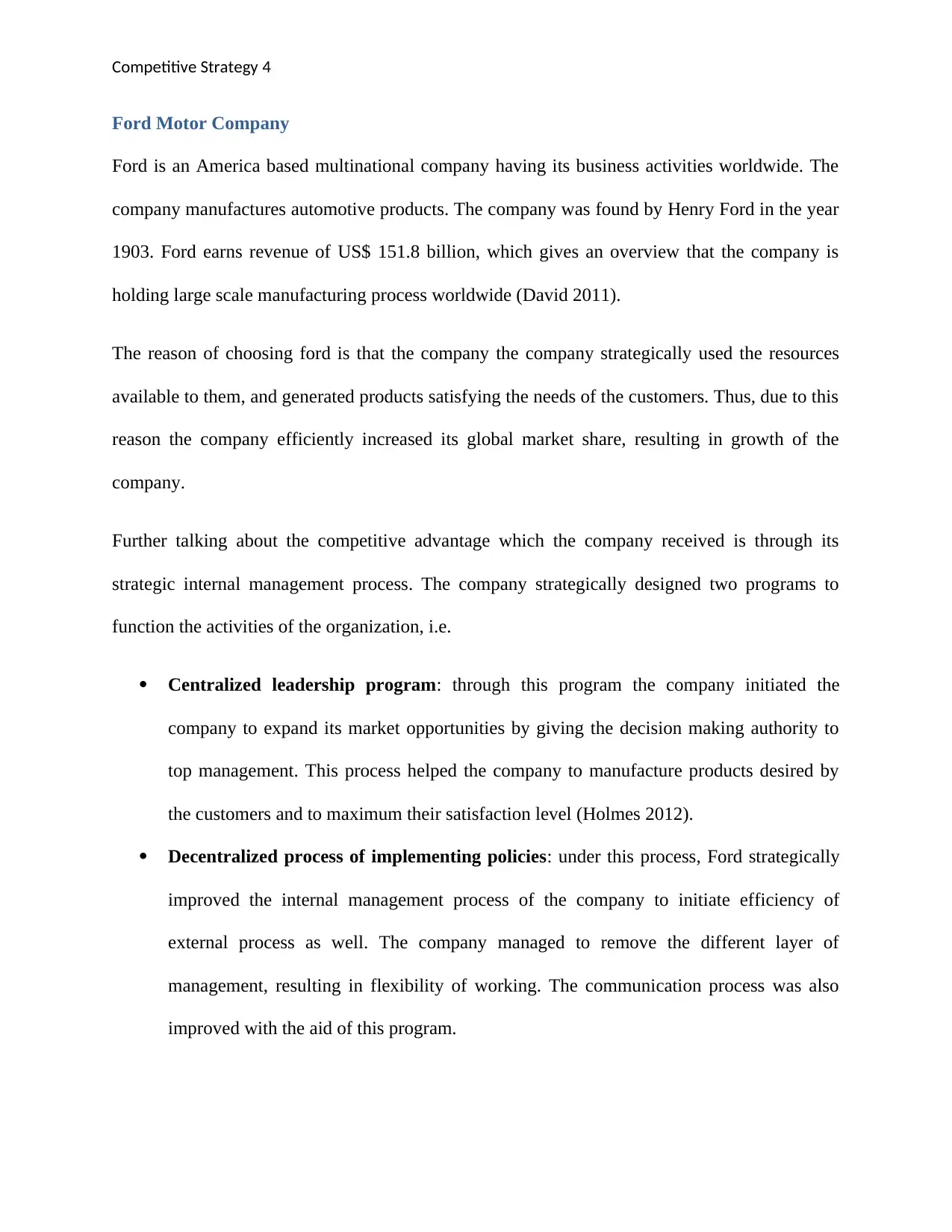
Competitive Strategy 4
Ford Motor Company
Ford is an America based multinational company having its business activities worldwide. The
company manufactures automotive products. The company was found by Henry Ford in the year
1903. Ford earns revenue of US$ 151.8 billion, which gives an overview that the company is
holding large scale manufacturing process worldwide (David 2011).
The reason of choosing ford is that the company the company strategically used the resources
available to them, and generated products satisfying the needs of the customers. Thus, due to this
reason the company efficiently increased its global market share, resulting in growth of the
company.
Further talking about the competitive advantage which the company received is through its
strategic internal management process. The company strategically designed two programs to
function the activities of the organization, i.e.
Centralized leadership program: through this program the company initiated the
company to expand its market opportunities by giving the decision making authority to
top management. This process helped the company to manufacture products desired by
the customers and to maximum their satisfaction level (Holmes 2012).
Decentralized process of implementing policies: under this process, Ford strategically
improved the internal management process of the company to initiate efficiency of
external process as well. The company managed to remove the different layer of
management, resulting in flexibility of working. The communication process was also
improved with the aid of this program.
Ford Motor Company
Ford is an America based multinational company having its business activities worldwide. The
company manufactures automotive products. The company was found by Henry Ford in the year
1903. Ford earns revenue of US$ 151.8 billion, which gives an overview that the company is
holding large scale manufacturing process worldwide (David 2011).
The reason of choosing ford is that the company the company strategically used the resources
available to them, and generated products satisfying the needs of the customers. Thus, due to this
reason the company efficiently increased its global market share, resulting in growth of the
company.
Further talking about the competitive advantage which the company received is through its
strategic internal management process. The company strategically designed two programs to
function the activities of the organization, i.e.
Centralized leadership program: through this program the company initiated the
company to expand its market opportunities by giving the decision making authority to
top management. This process helped the company to manufacture products desired by
the customers and to maximum their satisfaction level (Holmes 2012).
Decentralized process of implementing policies: under this process, Ford strategically
improved the internal management process of the company to initiate efficiency of
external process as well. The company managed to remove the different layer of
management, resulting in flexibility of working. The communication process was also
improved with the aid of this program.
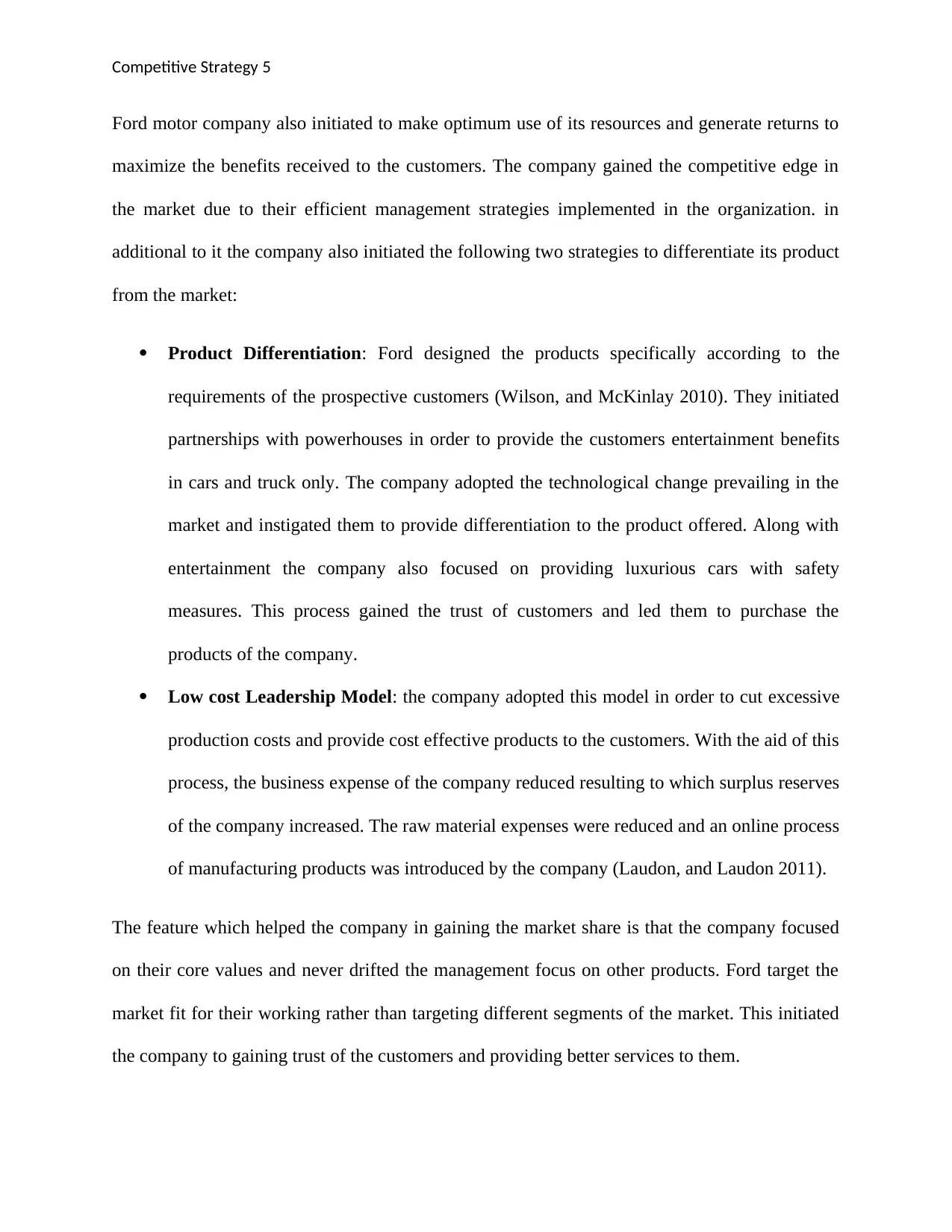
Competitive Strategy 5
Ford motor company also initiated to make optimum use of its resources and generate returns to
maximize the benefits received to the customers. The company gained the competitive edge in
the market due to their efficient management strategies implemented in the organization. in
additional to it the company also initiated the following two strategies to differentiate its product
from the market:
Product Differentiation: Ford designed the products specifically according to the
requirements of the prospective customers (Wilson, and McKinlay 2010). They initiated
partnerships with powerhouses in order to provide the customers entertainment benefits
in cars and truck only. The company adopted the technological change prevailing in the
market and instigated them to provide differentiation to the product offered. Along with
entertainment the company also focused on providing luxurious cars with safety
measures. This process gained the trust of customers and led them to purchase the
products of the company.
Low cost Leadership Model: the company adopted this model in order to cut excessive
production costs and provide cost effective products to the customers. With the aid of this
process, the business expense of the company reduced resulting to which surplus reserves
of the company increased. The raw material expenses were reduced and an online process
of manufacturing products was introduced by the company (Laudon, and Laudon 2011).
The feature which helped the company in gaining the market share is that the company focused
on their core values and never drifted the management focus on other products. Ford target the
market fit for their working rather than targeting different segments of the market. This initiated
the company to gaining trust of the customers and providing better services to them.
Ford motor company also initiated to make optimum use of its resources and generate returns to
maximize the benefits received to the customers. The company gained the competitive edge in
the market due to their efficient management strategies implemented in the organization. in
additional to it the company also initiated the following two strategies to differentiate its product
from the market:
Product Differentiation: Ford designed the products specifically according to the
requirements of the prospective customers (Wilson, and McKinlay 2010). They initiated
partnerships with powerhouses in order to provide the customers entertainment benefits
in cars and truck only. The company adopted the technological change prevailing in the
market and instigated them to provide differentiation to the product offered. Along with
entertainment the company also focused on providing luxurious cars with safety
measures. This process gained the trust of customers and led them to purchase the
products of the company.
Low cost Leadership Model: the company adopted this model in order to cut excessive
production costs and provide cost effective products to the customers. With the aid of this
process, the business expense of the company reduced resulting to which surplus reserves
of the company increased. The raw material expenses were reduced and an online process
of manufacturing products was introduced by the company (Laudon, and Laudon 2011).
The feature which helped the company in gaining the market share is that the company focused
on their core values and never drifted the management focus on other products. Ford target the
market fit for their working rather than targeting different segments of the market. This initiated
the company to gaining trust of the customers and providing better services to them.
⊘ This is a preview!⊘
Do you want full access?
Subscribe today to unlock all pages.

Trusted by 1+ million students worldwide

Competitive Strategy 6
Paraphrase This Document
Need a fresh take? Get an instant paraphrase of this document with our AI Paraphraser
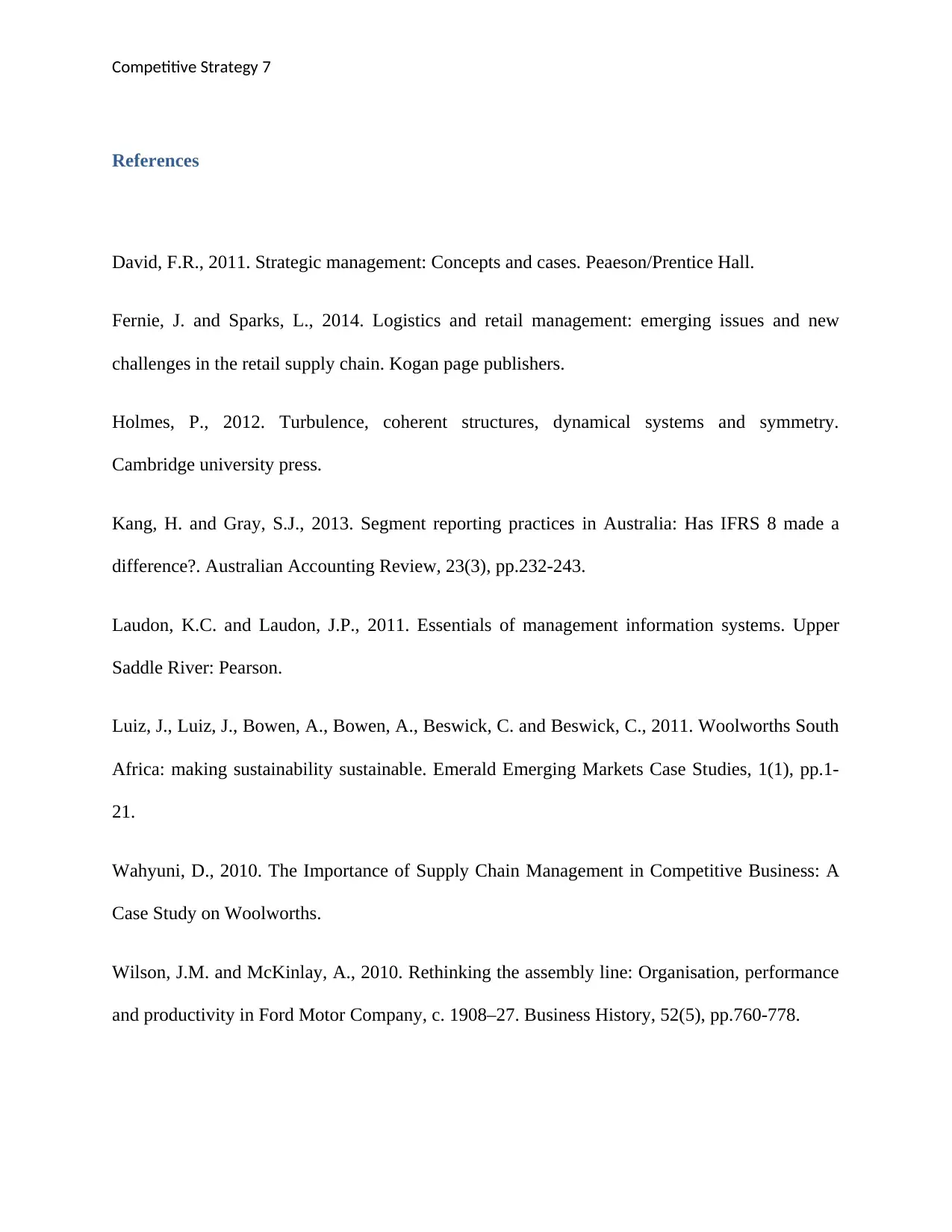
Competitive Strategy 7
References
David, F.R., 2011. Strategic management: Concepts and cases. Peaeson/Prentice Hall.
Fernie, J. and Sparks, L., 2014. Logistics and retail management: emerging issues and new
challenges in the retail supply chain. Kogan page publishers.
Holmes, P., 2012. Turbulence, coherent structures, dynamical systems and symmetry.
Cambridge university press.
Kang, H. and Gray, S.J., 2013. Segment reporting practices in Australia: Has IFRS 8 made a
difference?. Australian Accounting Review, 23(3), pp.232-243.
Laudon, K.C. and Laudon, J.P., 2011. Essentials of management information systems. Upper
Saddle River: Pearson.
Luiz, J., Luiz, J., Bowen, A., Bowen, A., Beswick, C. and Beswick, C., 2011. Woolworths South
Africa: making sustainability sustainable. Emerald Emerging Markets Case Studies, 1(1), pp.1-
21.
Wahyuni, D., 2010. The Importance of Supply Chain Management in Competitive Business: A
Case Study on Woolworths.
Wilson, J.M. and McKinlay, A., 2010. Rethinking the assembly line: Organisation, performance
and productivity in Ford Motor Company, c. 1908–27. Business History, 52(5), pp.760-778.
References
David, F.R., 2011. Strategic management: Concepts and cases. Peaeson/Prentice Hall.
Fernie, J. and Sparks, L., 2014. Logistics and retail management: emerging issues and new
challenges in the retail supply chain. Kogan page publishers.
Holmes, P., 2012. Turbulence, coherent structures, dynamical systems and symmetry.
Cambridge university press.
Kang, H. and Gray, S.J., 2013. Segment reporting practices in Australia: Has IFRS 8 made a
difference?. Australian Accounting Review, 23(3), pp.232-243.
Laudon, K.C. and Laudon, J.P., 2011. Essentials of management information systems. Upper
Saddle River: Pearson.
Luiz, J., Luiz, J., Bowen, A., Bowen, A., Beswick, C. and Beswick, C., 2011. Woolworths South
Africa: making sustainability sustainable. Emerald Emerging Markets Case Studies, 1(1), pp.1-
21.
Wahyuni, D., 2010. The Importance of Supply Chain Management in Competitive Business: A
Case Study on Woolworths.
Wilson, J.M. and McKinlay, A., 2010. Rethinking the assembly line: Organisation, performance
and productivity in Ford Motor Company, c. 1908–27. Business History, 52(5), pp.760-778.
1 out of 8
Related Documents
Your All-in-One AI-Powered Toolkit for Academic Success.
+13062052269
info@desklib.com
Available 24*7 on WhatsApp / Email
![[object Object]](/_next/static/media/star-bottom.7253800d.svg)
Unlock your academic potential
Copyright © 2020–2025 A2Z Services. All Rights Reserved. Developed and managed by ZUCOL.




